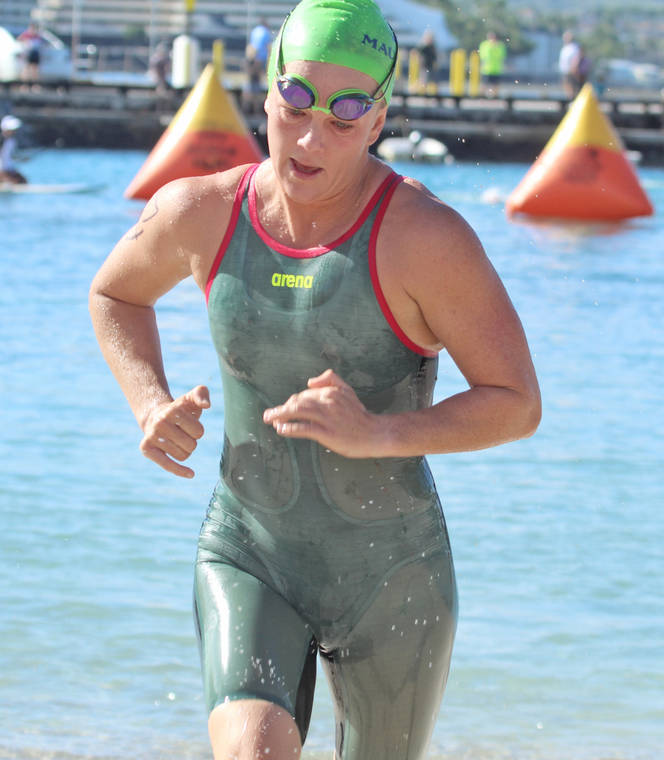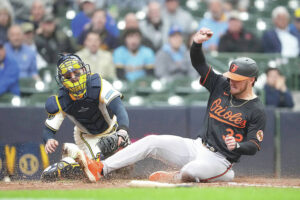Noelani Vargas remembers when she first starting competing at the Richardson Roughwater Swim as an 8-year-old when her late father, Roger, would drive her from Waimea to Hilo.
He passed away in 2018 when she captured her fourth title, and she grabbed a remarkable fifth medal on Sunday with a finish of 21 minutes and 49 seconds to become the first outright champion since Madison Hauanio’s 2016 win.
Justin Chow, a 2021 Kamehameha graduate, was second in 23:02 and Vargas’ friend and training partner, Susan Groff, of Waikoloa, was third in 23:11.
“I’ve been doing it since I was 8, maybe younger and did it about 15 times,” Vargas said. “The race was really good. Alex (Flores-Morikami, a P&R aquatics staffer) did a good job putting it out in the paper. They had four little stations for check-in. It felt super safe. I thought they were going to cancel it because of the huge increase in (COVID) numbers. I hope there are other open ocean water events.”
Vargas, 30, is a 2009 Hawaii Prep graduate who swam for four years at Loyola Marymount University and wanted to major in something easy until her dad stepped in.
“I wanted to do an easy major like art, but my dad intervened and said, ‘No, you’re not going to do that. Let’s look at the course catalog to find something for you to do.’ My pre-physical therapy major was science, and I liked it,” she said. “I was busy swimming. Luckily, my school was really supportive of the students doing well. After that, I got into graduate school and spent three years in Nevada. It was a great decision, and I really like my job.”
Vargas works at Mana Physical Therapy, a small outpatient service in Waimea, so she’s helped HPA and Parker swimmers with rehab work. It’s like a 3-for-1 bonus with Vargas, who can also offer advice on what it takes to become a collegiate swimmer and how to become a physical therapist.
“It’s a really long, difficult path. That’s why a lot of kids don’t make it through,” she said. “It’s four years of undergraduate then two to three years in a graduate program. It’s highly competitive to get into grad school, but it’s worth it.
“I like working in the town where I grew up in, Waimea since I was 5 years old. I like giving people the tools to help themselves to improve their own quality of life. I like helping people help themselves. I got a couple of swimmers from HPA and Parker, and we talk story, mostly about shoulder problems, maintaining shoulder stability.”
The act of swimming is pulling down on the shoulders, much like pitching in baseball. That’s one reason why Major League Baseball clubs spend so much on technology, not to find ways to cheat like the Houston Astros but to maintain arm health.
“There are simple exercises you can look up on YouTube. You have to work the front and back of the shoulders to create balance,” Vargas said. “I didn’t do distance swimming. I was in freestyle and backstroke. LMU gave me some scholarship money, and it ended up being a good choice. I’m still friends with all my teammates there.”
When Vargas talks to her old LMU teammates, she can share the Olympic story that she liked most, Australia’s Ariarne Titmus’ upset over U.S. star Katie Ledecky for the gold medal in the women’s 400-meter freestyle.
Vargas liked Aussie coach Dean Boxall’s wild celebration, which went viral, but she also admired Ledecky, who acted like a champion in both victory and defeat. Ledecky is considered the greatest of all time in women’s swimming with seven Olympic gold and 15 world championship gold medals.
“For people who don’t follow swimming, they think why didn’t she win the gold? You could see that the Australian swimmer worked hard for four years,” Vargas said. “Katie has a legacy that is unheard of. She demonstrated her composure the way she handled the interview. She was so well-composed. I loved watching her as a swimmer.”
Her dad worked at the UH-Hilo agriculture department and would take Vargas swimming in Hilo, mostly at Sparky Kawamoto pool. When she got older, she became friends with Groff, and the two would train two times a weekly at Hapuna.
All the memories of her dad, Roger, came flooding back to her after another Richardson Roughwater Swim title.
“When we were kids, he would always take us to the swim meets at Kawamoto,” she said. “It’s all about that parental support. He was always super supportive. Anything that makes me happy my mom, Kathy, is very supportive of.”
When Vargas is not swimming, she can be found bow hunting. Wait. What?
Her boyfriend, Chase Clark from Oregon, is a bow hunter. They like to go bow hunting on Molokai. But when she returns home, Vargas is back in the water, reliving all her best childhood memories again.






